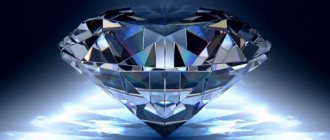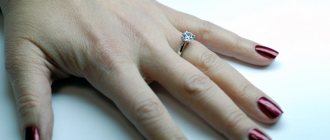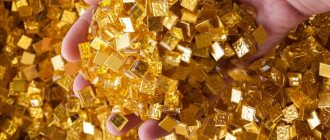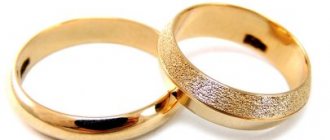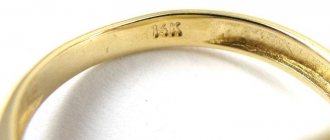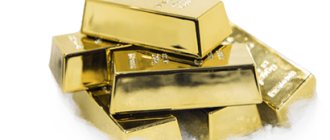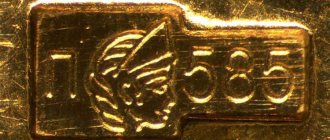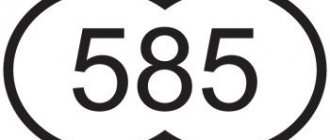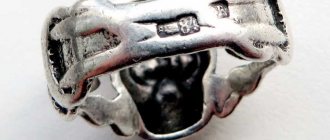Precious minerals, due to their splendor and radiant shine, have always attracted the eyes of people and become objects of admiration. However, what makes stones so expensive is not only their external beauty, but also their rarity. The cost of unique specimens reaches sky-high levels.
An equally important parameter for setting the price is the weight of the mineral. To measure the mass of precious stones, a non-standard unit is used - the carat, which is well known to jewelers. However, for an uninformed person, the weight of a carat in grams remains a mystery, so before buying expensive jewelry inlaid with diamonds or sapphires, you should know how much one carat weighs and how to determine the number of grams in a gem.
What is carat
To measure the mass of precious stones, the carat is used - a unit that has the designation ct and is equal to 0.2 grams. In England, the same value is used to determine the percentage of gold in the setting, but in this case the unit is abbreviated “K”.
It is important to note that the size of a gem is not measured in ct, since this is a unit of mass, not dimensions. In addition, the parameters of the jewelry insert largely depend on the cutting method by which the crystals take shape.
To determine the cost and value of a mineral, one must know how many cts are contained in a particular sample. When purchasing, do not forget that purity also affects the price, so more does not always mean better.
History of the unit
The history of the origin of the carat as a unit of measurement goes back to earlier times. In the old days there were no scales, so merchants and jewelry dealers had difficulty selling jewelry by original weight. A unified measurement system was invented that compares the size and mass of minerals.
To determine the weight of gems, grains of carato, a ceratonia plant that grew in the area where mineral mining took place, began to be used. In other countries, acacia grains were used as weights. However, the name “carat” owes its appearance to ceratonia. The fact is that the fruits of this tree had the same mass - 0.19 grams - regardless of the place of growth and time.
The measurement was officially agreed upon in 1907 during the Fourth General Conference.
In the USSR, official approval was received in 1922. From that moment on, the mass of jewelry began to be determined in ct.
Kinds
In the modern world, there are two types of units for measuring the mass of jewelry - metric and assay carat. The first is a measure of the weight of precious stones, the second determines the purity of the gold alloy.
Metric
The metric carat is a unit of measure adopted in all developed countries. Metric cts are used to measure the mass of unique and dazzling diamonds. The history of the origin of the unit of measurement goes back to antiquity, where the mass of minerals was determined using ceratonia fruits, which have an identical weight - 189 mg.
Difficulties began when traders discovered that the fruits differed in different countries. This created inconvenience and caused conflicts between merchants. As a result, the idea of adopting a single unit of mass arose, but this was opposed by Great Britain, which adhered to its metric system. Despite the difficulties, the jewelers soon agreed on a single ct - 0.2 grams.
Assay
This type is different from the metric carat and denotes a measure not of weight, but of the purity of the gold alloy. The hallmark carat was invented in Ancient Rome, when the emperor introduced a gold coin that weighed 24 K. A similar coin is still in active circulation in Great Britain. Other countries prefer to use percentages, for example, the 585-carat designation indicates that the jewelry contains 58.5% pure gold.
When using an assay unit to determine the purity of gold, the following ratio is taken: 24K is the pure metal content. Therefore, a piece containing half gold would be 12K. In Russia, the jewelry industry produces jewelry with hallmarks of 750, 585, and 375—18, 14, and 9 K, respectively.
Other stones
The weight of diamond imitation stones in jewelry can also be measured in carats. They use natural white minerals, for example, sapphire, topaz, beryl, zircon and rock crystal, as well as artificial ones - cubic zirconia, moissanite, spinel, strontium titanate and others.
It is very difficult even for professionals to identify a talented imitation by eye. But there are a number of ways you can make sure a diamond is real. Among them:
- Assessment of light refraction. The flow should be mirrored by the crystal faces in such a way that when the crown of the stone is brought to the light source, one sparkling point is visible.
- Interaction with hydrochloric acid. The diamond is resistant to hydrogen chloride, whereas fake stones remain stained.
- Scratch resistance. A diamond leaves scratches when it comes into contact with other stones, but at the same time retains its integrity.
- Immersion in water or glycerin. A real stone sparkles and therefore stands out well in the thickness of the liquid, while a fake becomes almost invisible.
- Use of special ultraviolet and electrical conductivity testers. The test is based on brilliance measurements and produces fairly accurate results, but may be misleading when using moissanite instead of diamond.
But some stones have their own jewelry value and have precious status. Their properties (in particular, carat weight) determine the value.
Blue sapphire
Aluminum oxide with impurities of titanium and iron in the matrix forms the blue sapphire gemstone. Cornflower blue is considered the classic color; darker shades are valued less. In addition, due to the admixture of chromium, stones are pink, due to vanadium - purple, and in the absence of titanium - yellow or green.
The largest natural sapphire was a crystal weighing 3.5 thousand carats. At first it was mistaken for a piece of rock crystal, but research showed its jewelry value. Subsequently, other large representatives were found, for example, the “Black Star of Queensland” weighing 733 carats, found by a twelve-year-old boy in Australia, or the “Logan” weighing almost 423 carats from Sri Lanka.
Estimating the number of carats in a sapphire by appearance is not difficult. There are special jewelry tables for this. The dependence is primarily determined by the shape of the stone. For example, a 1 carat sapphire has the following dimensions:
- for round - 6 mm;
- for oval, pear-shaped - 7 x 5 mm (for baguette and octagon shapes, these dimensions will correspond to 1.15 ct).
The price per carat will depend on the quality of the stone. The best minerals of pure cornflower blue color processed without thermal heating cost more than 60 thousand rubles. If the color is orange, purple or pink, then the price drops to 7.5 thousand, but when the total weight exceeds 5 carats, the specimen is considered rare and collectible, its value in some cases can reach one and a half million. The yellow sapphire is valued at 6 thousand, and the green sapphire at approximately 4 thousand.
Nowadays stones are not only mined from deposits, but also synthesized artificially. Their use is not limited to jewelry; they have also found application in optics, microcircuits, and lasers.
Colorless topaz
Topaz is a semi-precious stone. Like diamond, it is very hard, most often colorless, but sometimes due to structural defects there are stones of brown, blue, pink or golden shades, which can fade from bright light and heat and intensify the color when exposed to radiation. Mineral deposits are located in Russia, Ukraine, and Brazil. Sometimes specimens weighing several tons are mined.
Topaz imitates diamond so well that the 1,640-carat semi-precious stone was once mistaken for a diamond and presented to the King of Portugal. It was then incorrectly valued at £57 million. Now topaz is practically not in demand, since it differs too little from quartz. Estimated at approximately 1 thousand rubles per carat.
Green beryl
Ordinary opaque beryl stones are just an ore mineral, but if they contain vanadium or chromium oxide, which gives a rich and bright green color, then they are called emeralds and are considered precious. Moreover, a transparent stone of a deep green color without flaws weighing more than 5 carats will cost more than a diamond.
Emeralds of excellent quality and large mass have not been encountered very often throughout history. One of the famous specimens was a stone called "Queen Isabella". It weighed 964 carats and was the size of an ostrich egg.
Natural emerald almost always has cracks and chips, so a stone on which defects are not visible to the naked eye is considered flawless. Its cost per carat will vary from 250 to 400 thousand rubles. An emerald of good, but not impeccable quality will be valued from 30 to 300 thousand, depending on the defects identified, and commercial stones cost 18-19 thousand.
So, if it is now clear how much a gram is one carat, then its price for stones of different quality can vary widely. Therefore, a unit expresses only the weight of an object or the purity of gold, but by itself cannot fully characterize its value.
Difference between gold and diamond carats
To answer the question of how diamond carats differ from gold carats, it should be understood that these two definitions are used for different purposes:
- Diamond (metric) carats are used to indicate the weight of minerals, which include famous diamonds. The weight of one carat is 0.2 grams, the designation is ct.
- Gold (assay) standards determine the amount of pure gold and have the abbreviation K. In some countries, for example, in Russia, jewelry is made with hallmarks that can easily be converted to K.
The system for measuring the weight of gems and the gold content goes back to ancient times and is still used today. In the jewelry industry, carat scales with minimal error are used to determine weight in grams. To calculate carat content, there are many tables with the help of which even a person ignorant in this area can calculate the number of grams.
Ounce
For trading on the stock exchange, the troy ounce is used, which is a fairly accurate measurement. It should not be confused with those previously described. A troy ounce corresponds only to pure gold, with a purity level of 999 or higher. It indicates the weight of the metal, and in accordance with this helps to find out its price on the world market. By weight it is approximately 31.103 grams. If you purchase investment coins, bars, or a virtual amount of gold through a bank or exchange, you will encounter exactly this value, which is designated as ozt.
How many grams in one carat
At the beginning of the 20th century, jewelers agreed on the exact number of grams in a carat. In 1907, they decided to equate the weight of one carat to 0.2 grams. However, not all countries agreed to convert the mass into carats, continuing to use their own values. The countries adopted a unified standard in the following sequence:
- France - 1907
- Holland - 1911
- USA - 1913
- USSR - 1923
Following these states, other countries also decided to convert grams to carats. However, a 1 ct gem is a rare and expensive stone. Much more often you come across crystals with a smaller mass, not reaching 0.2 grams. But here, too, jewelers did not use standard measures and created their own unit - the point. It has been established that one ct (0.2 grams) is equal to 100 points.
How do the mass and diameter of precious gems relate?
Before visiting a jewelry store, a table of the ratio of the diameter, which is measured in millimeters or centimeters, and the weight of the mineral will help you find out approximately the cost of the stone. It is difficult to know the exact weight of a particular specimen, since the gems that go on sale have different cuts. At the same time, the primary goal of every jeweler is to maintain the weight of the original crystal, so gems of the same diameter can weigh differently.
The table will help you understand the intricacies of the relationship between carat and diameter (mm):
| Diameter in mm | Carat weight |
| 4,1 | 0,25 |
| 5,1 | 0,5 |
| 6,4 | 1 |
| 8,2 | 2 |
| 9,4 | 3 |
| 10,4 | 4 |
| 11 | 5 |
| 14 | 10 |
| 16 | 15 |
Similar tables that exist for each jewelry variety of stones allow you to find out the number of grams without removing the precious insert from the ring or earrings.
Diamond size
A 3 carat diamond of various shapes will have the following geometric dimensions:
- square shape – 5.55 mm. With such a cut, there is the least loss of stone, a small amount of waste. The most popular cuts are “princess” and “ascher”;
- round – 6.5 mm. The most popular cutting method, but also the most expensive, since there is a large loss of stone during processing. The cut makes the stone incredibly sparkling. Round diamonds are rightfully considered the most beautiful, transparent, and have an inner glow. It is the cutting that gives them additional transparency. Jewelers are still arguing about the required number of facets to fully reveal the beauty and transparency of the stone. The number of facets varies from piece to piece of jewelry;
- 9.8 × 5.6 mm - a shape reminiscent of the smile of the favorite of the French king, the Marquis de Pompadour, is called “marquise”;
- 7.7x5.9 mm – oval shape. A popular cut shape, as the stone has brilliance, round transparency, but is large in size;
- 6×5.5 mm – square cut with chopped edges, radiant, cushion shape;
- 8.6×5.8 mm – combined “pear” shape, consists of “marquise” and round shapes;
- 6.7x6.5 mm – “heart”. Diamonds are given by lovers to their other halves. Popular cut shape. Inserted into pendants, earrings, rings. The “heart” shape hides all the imperfections of the stone with this cut;
- 7.7×4.5 mm – oval shape, allows you to maintain the shine of the stone with minimal loss, similar to the “oval” shape, only with smaller dimensions;
- 6.4x4.9 mm – “emerald”. Suitable only for flawless diamonds with breathtakingly pure brilliance, otherwise with such a cut all the flaws of the stone will be visible. The most expensive jewelry with stones of this particular cut.
